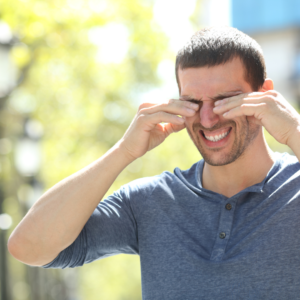Wearing Contact Lenses During Cold and Flu Season

Cold and flu season is upon us, and it’s important to take extra precautions to keep ourselves and our eyes healthy. While it’s generally safe to wear contact lenses when you have a cold or the flu, it might be wise to give your eyes a break and opt for glasses instead. Symptoms like sneezing and a runny nose can transfer germs to your hands and face, which can then end up in your eyes and potentially lead to an infection like conjunctivitis.
However, if you must wear contacts during this time, here are some helpful hygiene tips from Blumenstock Family Eyecare.
Limit your lens use: Only wear lenses when necessary. If you usually wear them every day, try taking days off and reducing the number of hours you have them in.
Practice good hand hygiene: Germs are most commonly transferred to the eyes through our hands. Follow the same hygiene rules as usual for inserting and removing your lenses, but be extra diligent. Wash your hands for at least 20 seconds with hot, soapy water using an antibacterial soap. Clean every part of your fingers and under your fingernails, where bacteria may hide, before touching your lenses.
Consider daily disposable lenses: Daily disposable lenses come in one-time-use sterilized blister packs, eliminating the need for an ongoing cleaning routine that could introduce additional contamination.
Don’t forget to disinfect accessories: Accessories like lens cases and solution bottles can harbor bacteria and serve as a potential source of infection. Make sure to clean and sanitize them regularly. It’s also a good practice to replace your contact lens case monthly.
Use drops for dry eyes: Infections or viruses can disrupt tear production and leave your eyes dehydrated. Certain medications used to treat illnesses can also cause dry eyes. Keep your eyes moisturized with lens-safe lubricating drops like Blink Intensive Triple-Action eye drops. These drops can be applied without removing your lenses, reducing the risk of contamination.
Eye infection awareness: If you suspect you have an eye infection, stop wearing your lenses and discard them along with the lens case. Contact your optician immediately. Avoid sharing towels with other household members to prevent the spread of infection. Only resume wearing contact lenses once authorized by your optician.
It’s best to give your eyes and body the rest they need when you’re feeling sick. Rely on your glasses until your symptoms have subsided. Once you’ve recovered, you can safely return to wearing contact lenses. Stay healthy and take care of your eyes during this cold and flu season. If you need a new pair of specs, we’d love to outfit you. Make your appointment today.
